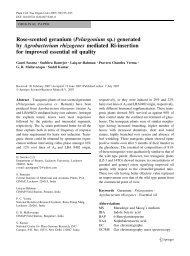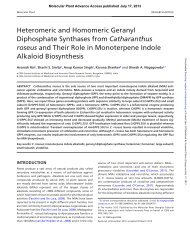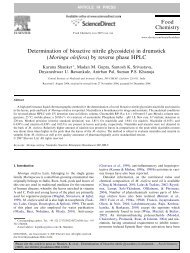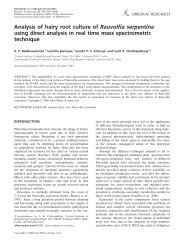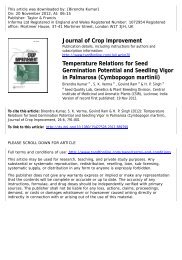Volume 2. Issue 1. ISSN 1555-9475 (online) www ... - CIMAP Staff
Volume 2. Issue 1. ISSN 1555-9475 (online) www ... - CIMAP Staff
Volume 2. Issue 1. ISSN 1555-9475 (online) www ... - CIMAP Staff
- No tags were found...
Create successful ePaper yourself
Turn your PDF publications into a flip-book with our unique Google optimized e-Paper software.
94 Natural Product Communications Vol.2 (1) 2007Misra et al.material is reported. To resolve the ‘Safed Musli’complex and to differentiate Chlorophytum species inthis group and A. adscendens, an AFLP-basedexperiment was carried out with the aim ofdeveloping molecular markers for plantauthentication purpose.From a study of the crude drug it is very difficult toidentify the species present in the mixture. Althoughthe anatomical features are differentiable betweenCholorophytum and Asparagus, they are not helpfulin distinguishing between the various species ofChlorophytum. Besides, in the crude drug, it is notpossible to study the anatomical features unless intactroots are obtained. So the AFLP based-approach wasundertaken to generate a database of uniquefragments of DNA. The logic behind this was that theisolated DNA from the crude drug, when subjected toAFLP analysis, would provide an indication of thepresence of the different taxa, based on the proximityof fragment-match.PCR-based markers have been used extensively forassessing genetic variation within a species tomeasure its genetic diversity [7, 8]. Amplifiedfragment length polymorphisms (AFLP) are ideallysuited to assess germplasm because of their ability togenerate and detect numerous polymorphisms thatare largely distributed throughout the genome, andthe method is highly reproducible [5, 9, 10]. TheAFLP method largely detects single nucleotidepolymorphisms [11]. The discriminatory power ofAFLP has been used to distinguish between closelyrelated inbred species, cultivars and ecotypes, such asLactuca [12,13] and Arabidopsis thaliana [14], andwas shown to detect mutations in plants arising fromin vitro clonal propagation of Arabidopsis [15].So, for achieving the objective to resolve the‘Safed Musli’ complex and differentiatingC. borivilianum from other species of Chlorophytumand A. adscendens, an AFLP-based experiment wascarried out for developing molecular markers forplant authentication purpose. To study the geneticrelatedness of C. borivilianum with other species ofChlorophytum (C. arundinaceum, C. tuberosum andA. adscendens), molecular characterization of theseplants was carried out with a set of 64 AFLPselective primer combinations (MseI/EcoRI). Theplant material used for isolation of template DNA forAFLP was generated by pooling leaf samples from adiverse population of plants so as to give properrepresentation to all the genotypes available in aparticular case. Of the 64 primer combinations, only38 primers responded positively to genomicamplification, producing discrete bands with all thesamples. These primers produced a total of 1427bands. Of these, 17 were monomorphic and 1410were polymorphic. Among the polymorphic bands,1128 bands were unique. The analysis revealed ~96%polymorphism among the species. In this case, mostof the polymorphic bands were unique. Thishappened because plants taken in the analysis wereeither from a different genus or different species ofthe same genus. As small changes in the geneticcomposition generate a lot of unique bands in AFLPanalysis, this may be the reason for obtaining toomany unique bands at interspecific and intergenericlevel.Figure 1: Cluster diagram of Chlorophytum species and Asparagusadscendens showing relationship among them.The cluster diagram (Figure 1) generated aftercluster analysis showed two major groups. In thefirst, A. adscendens was clustered along withC. borivilianum, showing 60% similarity. In thesecond group, C. arundinaceum and C. tuberosumwere clustered together, showing 40% similarity. Thetwo groups were 25% diverse. Unique bands for allthe species were detected and tabulated (Table 1) foridentification of adulterants. In the case ofC. borivilianum 152, of C. arundinaceum 431, ofC. tuberosum 197, and of A. adscendens 348 bandswere found to be unique. The size of these uniquebands ranged between 50 bp and 400 bp. Themaximum number of unique bands was detected inthe case of C. arundinaceum, followed byA. adscendens, C. borivilianum and C. tuberosum.From this analysis we can infer that C. borivilianumis closer to A. adscendens than to the other species ofChlorophytum analyzed in this study. The DNAfingerprint comprised of the unique bands obtainedfor each of the four pooled populations will provide areference tool to identify adulterants in the crude





